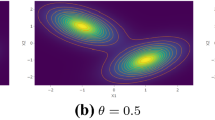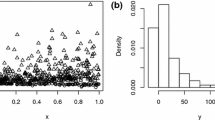Abstract
Given i.i.d. observations x1,x2,x3,...,xn drawn from a mixture of normal terms, one is often interested in determining the number of terms in the mixture and their defining parameters. Although the problem of determining the number of terms is intractable under the most general assumptions, there is hope of elucidating the mixture structure given appropriate caveats on the underlying mixture. This paper examines a new approach to this problem based on the use of Akaike Information Criterion (AIC) based pruning of data driven mixture models which are obtained from resampled data sets. Results of the application of this procedure to artificially generated data sets and a real world data set are provided.
Similar content being viewed by others
References
Akaike, H. (1974) A new look at the statistical model identification. IEEE Transactions on Automatic Control, 19, 716–23.
Binder, D. A. (1978) Bayesian cluster analysis. Biometrika, 65(1), 31–8.
Bozdogan, H. and Sclove, S. L. (1984) Multi-sample cluster analysis using Akaike's information criterion. Annals of the Institute of Statistics and Mathematics, 36, 163–80.
Carmen, C. S. and Merickel, M. (1990) Supervising isodata with an information theoretic stopping rule. Pattern Recognition, 23, 185–97.
Dempster, A. P., Laird, N. M. and Rubin, D. B. (1977) Maximum likelihood from incomplete data via the EM algorithm. Journal of the Royal Statistical Society, Series B, 39, 1–38.
Efron, B. and Tibshirani, R. (1993) An Introduction to the Bootstrap, London: Chapman and Hall.
Everitt, B. S. and Hand, D. J. (1981) Finite Mixture Distributions, London: Chapman and Hall.
Liang, Z., Jaszczak, R. J. and Coleman, R. E. (1992) Parameter estimation of finite mixtures using the EM algorithm and information criteria with applications to medical image processing. IEEE Transactions on Nuclear Science, 39(4), 1126–33.
Marron, J. S. and Wand, M. P. (1992) Exact mean integrated squared error. Annals of Statistics, 20(2), 712–36.
McLachlan, G. J. (1987) On bootstrapping the likelihood ratio test statistic for the number of components in a normal mixture. Applied Statistics, 36(3), 318–24.
McLachlan, G. J. and Basford, K. E. (1988) Mixture Models, New York: Marcel Dekker.
Milligan, G. W. and Cooper M. C. (1985) An examination of procedures for determining the number of clusters in a data set. Psychometrika, 50(1), 159–79.
Parzen, E. (1979) Nonparametric statistical data modeling. Journal of the American Statistical Association, 74, 105–31.
Priebe, C. E. (1994) Adaptive mixtures. Journal of the American Statistical Association, 89, 796–806.
Priebe, C. E. and Marchette, D. J. (1993) Adaptive mixture density estimation. Pattern Recognition, 26(5), 771–85.
Priebe, C. E., Solka, J. L. and Rogers, G. W. (1993) Discriminant analysis in aerial images using fractal based features. In F. A. Sadjadi (ed.) Adaptive and Learning Systems II, Proc. SPIE 1962, pp. 196–208.
Priebe, C. E., Solka, J. L., Lorey, R. A., Rogers, G. W., Poston, W. L., Kallergi, M., Qian, W., Clarke, L. P. and Clark, R. A. (1994) The application of fractal analysis to mammographic tissue classification. Cancer Letters, 77, 183–89.
Scott, D. W. (1985b) Frequency polygons. Journal of the American Statistical Association, 80, 348–54
Scott, D. W. (1985b) Average shifted histograms: effective non-parametric density estimation in several dimensions. Annals of Statistics, 13, 1024–40.
Scott, D. W. (1992) Multivariate Density Estimation, New York: John Wiley.
Scott, D. W. (1994) Multivariate Density Estimation, Short Course Interface 1994.
Silverman, B. W. (1986) Density Estimation for Statistics and Data Analysis. New York: Chapman and Hall.
Solka, J. L. (1995) Matching Model Information Content to Data Information, PhD Dissertation, George Mason University, Fairfax, Virginia.
Solka, J. L., Priebe, C. E. and Rogers, G. W. (1992) An initial assessment of discriminant surface complexity for power law features. Simulation, 58(5), 311–18.
Solka, J. L., Priebe, C. E. and Rogers, G. W. (1993) A probabilistic approach to fractal based texture discrimination. In F. A. Sadjadi (ed.) Adaptive and Learning Systems II, Proc. SPIE 1962, pp. 209–18.
Solka, J. L., Priebe, C. E., Rogers, G. W., Poston, W. L. and Lorey, R. A. (1994) Maximum likelihood density estimation with term creation and annihilation. In Computationally Intensive Statistical Methods, Proceedings of the 26th Symposium on the Interface, pp. 222–25.
Solka, J. L., Poston, W. L. and Wegman, E. J. (1995) A visualization technique for studying the iterative estimation of mixture densities. Journal of Computational and Graphical Statistics, 4(3), 180–97.
Sturges, H. A. (1926) The choice of a class interval. Journal of the American Statistical Association, 21, 65–6.
Titterington, D. M. (1984) Recursive parameter estimation using incomplete data. Journal of the Royal Statistical Society, Series B, 46, 257–67.
Titterington, D. M., Smith, A. F. M. and Makov, V. E. (1985) Statistical Analysis of Finite Mixture Distributions, New York: Wiley.
Wallace, C. S. and Boulton D. M. (1968) An information measure for classification. Computer Journal, 11, 185–94.
Wegman, E. J. (1970) Maximum likelihood estimation of a unimodal density function. Annals of Statistics, 41, 457–71.
Author information
Authors and Affiliations
Rights and permissions
About this article
Cite this article
Solka, J.L., Wegman, E.J., Priebe, C.E. et al. Mixture structure analysis using the Akaike Information Criterion and the bootstrap. Statistics and Computing 8, 177–188 (1998). https://doi.org/10.1023/A:1008924323509
Issue Date:
DOI: https://doi.org/10.1023/A:1008924323509




